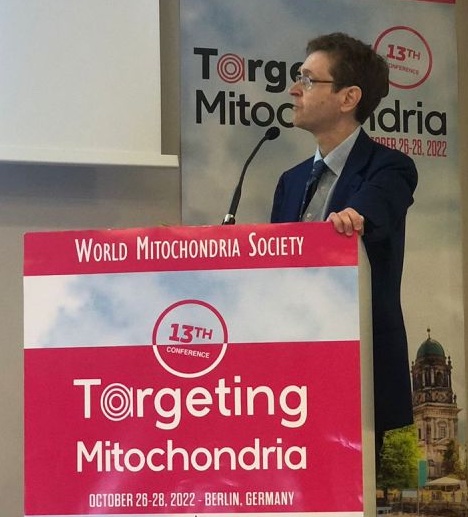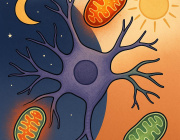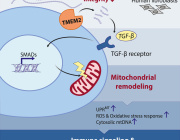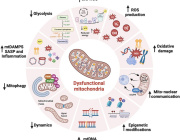Restoration of Mitochondrial Homeostasis provides Glaucoma Neuroprotection
Prof . Arupratan Das from Indiana University School of Medicine, USA will join the Targeting Mitochondria 2023 congress and present his study on "Restoration of Mitochondrial Homeostasis provides Glaucoma Neuroprotection".
. Arupratan Das from Indiana University School of Medicine, USA will join the Targeting Mitochondria 2023 congress and present his study on "Restoration of Mitochondrial Homeostasis provides Glaucoma Neuroprotection".
Neurons are highly energy-demanding due to their constant need for neurotransmission and synaptic activity. Mitochondria are the primary source for cellular energy currency adenosine triphosphate (ATP), and dysfunctional mitochondria present a key pathological condition for the central nervous system (CNS) disorders such as glaucoma, amyotrophic lateral sclerosis (ALS) and Parkinson’s disease. Retinal ganglion cells (RGCs) of the optic nerve are particularly vulnerable to mitochondrial dysfunctions as they need steady supply of ATP for varying frequency of action potential firing through the long unmyelinated axons. Here, using human stem cell differentiated retinal ganglion cells (hRGCs) we have shown hRGCs are efficient in degrading damaged mitochondria and producing simultaneously healthy organelle for maintaining mitochondrial homeostasis.
However, a glaucomatous Optineurin mutant (E50K) hRGCs show high ATP production rate with fewer mitochondrion compared to the wild-type neurons causing mitochondrial swelling and disruption of homeostasis. Remarkably, enhancing mitochondrial biogenesis through pharmacological inhibition of the Tank binding kinase 1 (TBK1) restores energy homeostasis, mitigates mitochondrial swelling with neuroprotection against acute mitochondrial damage for glaucomatous hRGCs, revealing a novel neuroprotection mechanism.
Join Targeting Mitochondria 2023 to learn more about Prof. Arupratan Das's talk. Read more about Prof. Das's research.
Targeting Mitochondria 2023 Congress
October 11-13, 2023 - Berlin, Germany
The role of Mitochondria in Liver Regeneration

Prof. Jiri Neuzil from Griffith University, Australia will join the Targeting Mitochondria 2023 congress which will be held on October 11-13, 2023 in Berlin, Germany, and will present a talk entitled "The role of Mitochondria in Liver Regeneration".
Prof. Neuzil focuses on the role of mitochondria in cancer. Major projects of his laboratory are mitochondria as a target for cancer therapy; horizontal transfer of mitochondria; the role of respiratory complexes in the biology and function of mitochondria; role of metabolic switch in malignant transformation and tissue regeneration. He developed a novel anti-cancer drug, mitochondrially targeted tamoxifen (MitoTam), an analogue of tamoxifen tagged with a delocalized cation (triphenylphosphonium) that preferentially targets the inner mitochondrial membrane of cancer cells, interfering with mitochondrial respiratory complex I. MitoTam has recently underwent Phase I/Ib clinical trial with efficacy against renal cell carcinoma.
Prof. Neuzil obtained his Ph.D. from the Institute of Microbiology in Prague, then he was a post-doctoral fellow at the Heart Research Institute in Sydney, Australia. After 3 years at the University of Munich as a Junior Group Leader and one year as a visiting researcher at the University of Linkoping (Sweden), he got the position of Senior lecturer in 2002 (later on Associate Professor and Professor) at Griffith University in Southport, Qld, Australia. Since 2006, he is a Group Leader at the Institute of Biotechnology, Czech Academy of Sciences in Prague. He has published over 245 scientific papers and his HI is 62.
Join Targeting Mitochondria 2023 to learn more about Prof. Neuzil's talk.
Targeting Mitochondria 2023 Congress
October 11-13, 2023 - Berlin, Germany
Protein Transport across Mitochondrial Membranes
 Dr. Peter Rehling, from University Medical Center Göttingen, Germany will join the Targeting Mitochondria 2023 congress and present his research on "Protein Transport across Mitochondrial Membranes".
Dr. Peter Rehling, from University Medical Center Göttingen, Germany will join the Targeting Mitochondria 2023 congress and present his research on "Protein Transport across Mitochondrial Membranes".
In his talk, Dr. Rehling will share his latest research on the molecular mechanisms of protein import into mitochondria, focusing on recent advances in understanding the role of protein chaperones and translocases.
Join Targeting Mitochondria 2023 to learn more about Prof. Rehling's interesting talk.
Targeting Mitochondria 2023 Congress
October 11-13, 2023 - Berlin, Germany
Mitochondrial Stress as a Central Biological Hub for Spaceflight Impact
 During the Targeting Mitochondria 2023 congress, Dr. Afshin Beheshti, Blue Marble Space Institute of Science, USA will give a presentation entitled "Mitochondrial Stress as a Central Biological Hub for Spaceflight Impact".
During the Targeting Mitochondria 2023 congress, Dr. Afshin Beheshti, Blue Marble Space Institute of Science, USA will give a presentation entitled "Mitochondrial Stress as a Central Biological Hub for Spaceflight Impact".
Join Targeting Mitochondria 2023 to learn more about Dr. Beheshti's talk.
Targeting Mitochondria 2023 Congress
October 11-13, 2023 - Berlin, Germany
Personalized Medicine in Mitochondrial Health and Disease: Myth and Reality
 Prof. Ciro Leonardo Pierri from the University of Bari, Italy, will join the 14th edition of the World Conference on Targeting Mitochondria 2023, held in Berlin, Germany, from October 11th to 13th. In this conference, Prof. Pierri will give a talk entitled "Personalized Medicine in Mitochondrial Health and Disease: Myth and Reality.
Prof. Ciro Leonardo Pierri from the University of Bari, Italy, will join the 14th edition of the World Conference on Targeting Mitochondria 2023, held in Berlin, Germany, from October 11th to 13th. In this conference, Prof. Pierri will give a talk entitled "Personalized Medicine in Mitochondrial Health and Disease: Myth and Reality.
Mitochondrial diseases may result from mutations affecting nuclear or mitochondrial genes, encoding mitochondrial proteins, or non-protein coding mitochondrial RNA. Despite the great variability of affected genes, in the most severe cases, a neuromuscular degenerative phenotype is observed, and no specific therapy exists for a complete recovery from the disease.
The most used treatments are symptomatic based on the administration of antioxidant cocktails in combination with antiepileptic/antipsychotic drugs. Unfortunately, antioxidant therapies have met limited success and it is still urgent to highlight new/real pharmacological targets and to design/identify highly selective/efficient drugs to rescue mitochondrial-impaired pathways. In this context, very little attention was dedicated to proteins responsible for the crosstalk between mitochondria and cytoplasm such as mitochondrial transporters (i.e., SLC25A family members) and FAD/NADH dehydrogenases (i.e., AIF), playing a crucial role in the maintenance of metabolites and oxidative balance, as well as in the regulation of mitochondrial apoptosis.
Prof. Pierri will discuss molecular aspects of the limited success of antioxidant therapies, and will illustrate the role of mitochondrial transporters and FAD/NADH dehydrogenases in mitochondrial function for the possible development of new MD treatments.
Join Targeting Mitochondria 2023 to learn more about Prof. Perrie's talk.
Targeting Mitochondria 2023 Congress
October 11-13, 2023 - Berlin, Germany
Winner of the Best Mitochondria Image 2022: Erminia Donnarumma, Institut Pasteur

The World Mitochondria Society congratulates the winner of the Best Mitochondria Image 2022 Erminia Donnarumma, Institut Pasteur, France. Her image entitled "Mitochondria run parallel in mature cardiomyocytes" shows: Adult primary cardiomyocytes (mouse) stained with TMRE (mitochondria, orange) and NucBlue (nuclei, blue).
 Dr. Donnarumma performed her PhD (2012-2015) in Pharmaceutical Sciences between the University of Naples Federico II in Italy and the Cardiovascular Center of Excellence in New Orleans (USA). Her work focused on the identification of new medications that could act or improve the crosstalk between the hydrogen sulfide (H2S) and nitric oxide (NO) signaling in small and large animal models of heart failure induced by myocardial ischemia and reperfusion injury. After this time, she nucleated my interest in mitochondria as therapeutic target in cardiac diseases. She therefore moved to France in 2016 to join the Wai Lab at the Institut Pasteur.
Dr. Donnarumma performed her PhD (2012-2015) in Pharmaceutical Sciences between the University of Naples Federico II in Italy and the Cardiovascular Center of Excellence in New Orleans (USA). Her work focused on the identification of new medications that could act or improve the crosstalk between the hydrogen sulfide (H2S) and nitric oxide (NO) signaling in small and large animal models of heart failure induced by myocardial ischemia and reperfusion injury. After this time, she nucleated my interest in mitochondria as therapeutic target in cardiac diseases. She therefore moved to France in 2016 to join the Wai Lab at the Institut Pasteur.
Dr. Donnarumma stated: "The main focus of my work was to investigate the role of Mitochondrial Fission Process 1 (MTFP1) in mitochondrial dynamics and the heart homeostasis. I discovered that MTFP1 loss in cardiomyocytes impairs mitochondrial inner membrane integrity leading to impaired mitochondrial bioenergetics, cardiomyocyte death and inflammatory dilated cardiomyopathy. My on-going and future researches aim at the understanding how mitochondria trigger inflammation in cardiomyocytes and the relevance of the sex bias that exists at the level of mitochondria for the development of sex- specific cardiac diseases".
You will be able to submit your images for #BestMitochondriaImageContest 2023 shortly.
World Mitochondria Society
14th Targeting Mitochondria 2023 Congress
October 11-13, 2023 - Berlin, Germany
LinkedIn | Facebook
Steigenberger Hotel Am Kanzleramt: Venue of Targeting Mitochondria 2023

The 14th World Congress on Targeting Mitochondria on October 11-13, 2023 in
Steigenberger Hotel Am Kanzleramt
Ella-Trebe-Straße 5
10557 Berlin, Germany
- Via email on This email address is being protected from spambots. You need JavaScript enabled to view it.
- By phone: +49 30 740 743 990
- Or by fax: +49 30 740 743 816
You can let them know that you are attending Targeting Mitochondria 2023. You can also use the code "WMS2023" in your communication with them.
World Mitochondria Society
14th Targeting Mitochondria 2023 Congress
October 11-13, 2023 - Berlin, Germany
www.wms-site.com
Professor Vladimir Skulachev, 87 years old – All our Condolences
 Sad news came from Russia. On February 5, prominent scientist Academician Vladimir Skulachev passed away at the age of 87. He was internationally renowned and highly respected mitochondriologist because of his groundbreaking research in bioenergetics.
Sad news came from Russia. On February 5, prominent scientist Academician Vladimir Skulachev passed away at the age of 87. He was internationally renowned and highly respected mitochondriologist because of his groundbreaking research in bioenergetics.
Vladimir Skulachev graduated from the biology and soil faculty of Moscow State University (1957), where he has been working since 1960. In 1961 he defended his Ph.D. thesis "The ratio of oxidation and phosphorylation in the respiratory chain."
In 1965-1973 he was the head of the bioenergy department of the Interfaculty Laboratory of Bioorganic Chemistry, since 1973 he was the head of the Laboratory of Bioorganic Chemistry.
In 1991, he became the Director of the Institute of Physical and Chemical Biology named after Belozersky.
In 2002, he founded the Faculty of Bioengineering and Bioinformatics at the Moscow State University and has been its dean to this day.
Among his scientific interests were the mechanisms of biological oxidation, transformation of chemical energy into electrical energy on mitochondrial membranes, the role of membrane potential as a factor conjugating the release and accumulation of energy in the cell. Since 2005, he has been leading a project to create a geroprotector drug based on mitochondria-targeted antioxidants.
Vladimir Skulachev, together with Efim Lieberman, obtained one of the first experimental proofs of the Mitchell’s chemiosmotic theory (Skulachev V.P., Sharaf A.A., and Liberman E.A. // Nature. 1967. V.216. N.5116. P.718-719). Using lipophilic cations and anions, they showed that energized mitochondria can accumulate cations, while submitochondrial particles, anions. In addition to the importance of the results obtained, in this work, the term "protonophore" was first introduced into the scientific literature, which is successfully used to this day. This publication was received with great interest by the scientific community and in recognition of its importance, these ions were named "Skulachev ions” by the famous American biochemist David Green. For this work, in 1975 Vladimir Skulachev was awarded the State Prize of the USSR.
Vladimir Skulachev was a Full member of the Russian Academy of Natural Sciences, member of the European Academy and president of the club of its Russian members, president of the All-Russian Biochemical Society, honorary president of the All-Russian Society of Biochemists and Molecular Biologists, full member of the Academy of Creativity; doctor honoris causa of Vilnius University.
From the first Congress “Targeting mitochondria” in the year 2010, he was a member of the scientific committee and its regular speaker. He regularly took part in the World Mitochondria Society's strategic discussions about the future of mitochondria in health and the strategies on how to progress in this subtle field.
On behalf of the WMS, Volkmar Weissig (President), Marvin Edeas (Founder), and Vladimir Gogvadze (Chairman of the board), we share our all sadness and sympathy with his family and colleagues.
The next meeting on Targeting Mitochondria will be dedicated to Professor Skulachev's legacy in the world of mitochondria.
Prof. Volkmar Weissig: Editor in Chief at the "Journal of Mitochondria, Plastids and Endosymbiosis"

We would like to anounce that the president of WMS, Prof. Volkmar Weissig, is now serving as one Editor-in-Chief in the new journal by Taylor & Francis "Journal of Mitochondria, Plastids and Endosymbiosis" along with Prof. Dario Leister, Munich, Germany.
We also mention the associate editors:
Prof. Alessandro Prigione - Heinrich Heine University, Germany
Prof. Alisdair Fernie - Max Planck Insitute of Plant Physiology, Germany
Prof. Kelvin Yen - Leonard Davis School of Gerontology, USA
Prof. Marvin Edeas - Université de Paris, INSERM, France
Prof. Sally Mackenzie - Penn State, Huck Insitutes of Life Sciences, USA
Prof. Virginia Weis - Oregon State, USA
Prof. Vyacheslav Jurchenko - University of Ostrava, Czechia
Prof. Christian Schmitz-Linneweber - Humboldt Univeritat zu Berlin, Germany
Prof. Toshiharu Shikanai - Kyoto University, Japan
Prof Iris Finkemeier - WWU Münster, Germany
This journal is dedicated to serving the biology community by publishing novel and exciting findings with high significance in the biology of mitochondria, plastids and endosymbiosis. It focuses broadly on cellular biology, physiology, biochemistry, molecular biology, genetics, development, genomics, biomedicine, pharmacology, toxicology, bioinformatics, and molecular evolution, as well as on organismic interactions relevant in the context of endosymbiosis. Prof. Weissig will be covering the mitochondria in the endosymbiotic journal section.
Prof. Marvin Edeas, Founder of WMS, Université de Paris, INSERM, stated that: "The World Mitochondria Society will try to connect tightly with the Journal of Mitochondria, Plastids and Endosymbiosis to disseminate the meetings information and activities".
The journal is now open for submission. You can find more details here.
World Mitochondria Society: Collecting Memories 2022
On behalf of the World Mitochondria Society, we would like to let you know that the Targeting Mitochondria 2022 memories are now accessible. Please find the images here.
Nominations for The Best Mitochondria Image 2022
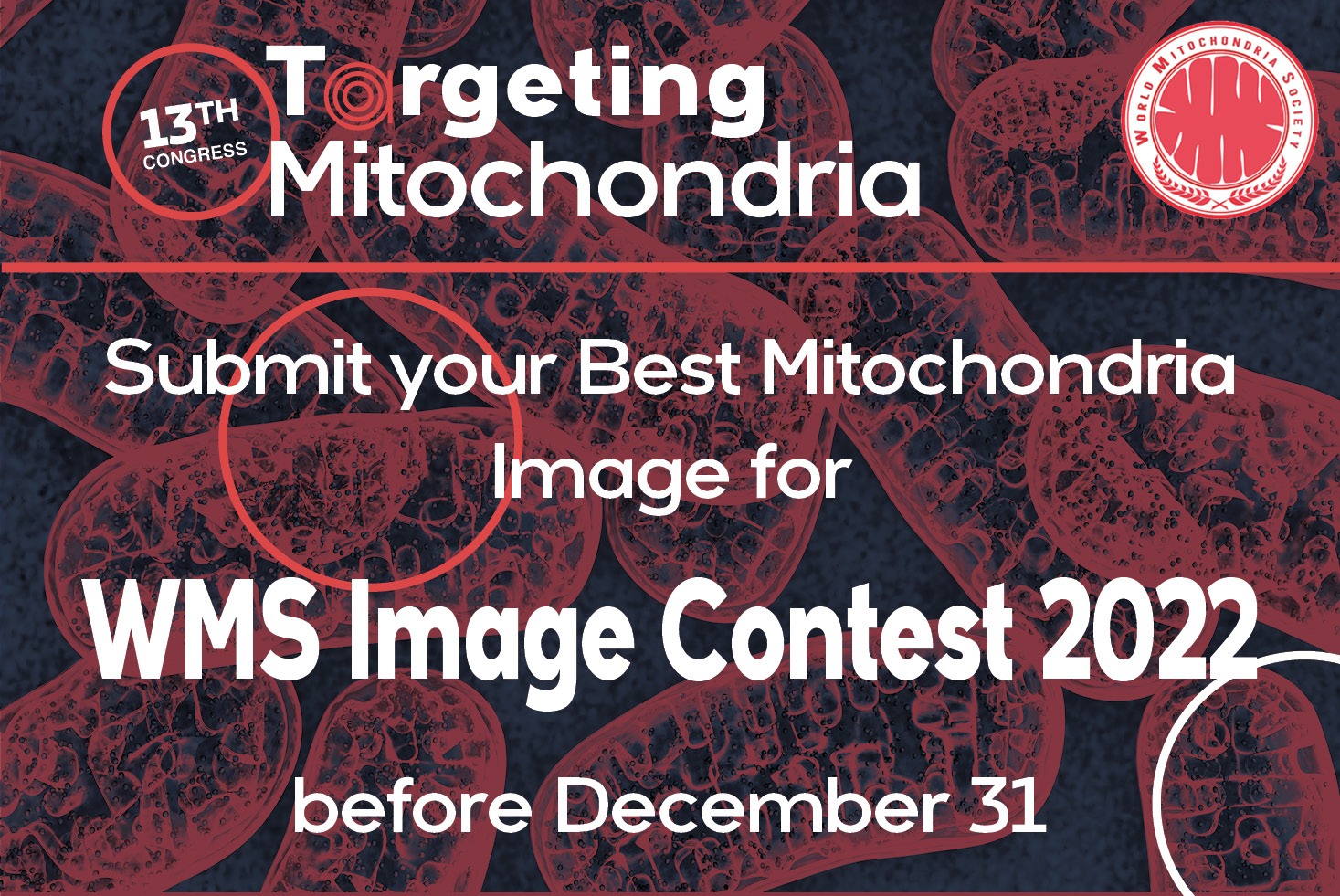
The World Mitochondria Society Scientific Committee will keep accepting images until the end of December 2022! Submit a memorable Mitochondria Image you’ve taken this past year and get the chance to win a free registration for Targeting Mitochondria 2023. Image submissions guidelines.
Images will be shared on the World Mitochondria Society Linked In page. You can vote for your favorite image by pressing the like button. You can find all the nominated images below.
Mitochondrial Crystals
By Catherine Griffiths, Biomedical Imaging Unit Southampton

Mitochondrial fireworks – The Ring of Fire
By Simon Licht-Mayer, Institute of Molecular Biotechnology of the Austrian Academy of Sciences

Dorsal root ganglia neurons stained for Neurofilament heavy chain (NF200, green), isolectin B4 (IB4, red), calcitonin gene-related peptide (CGRP, cyan), cytochrome c oxidase I (COX-I, orange)
Ultrastructural Resolution of Different Mitochondrial Compartments
By Tasnim Arroum, Westfälische Wilhelms-University Münster

Inheritance
By Therese Kichuk, PhD Student in Molecular Biology at Princeton University

This image shows clusters of the budding yeast Saccharomyces cerevisiae. Mitochondria are shown in green and the endoplasmic reticulum is shown in red.
Reshaping of Mitochondria During Diabetes
By Licia Anna Pugliese and Luca Pesce, NEST ( National Enterprise for nanoScience and nanoTechnology),Scuola Normale Superiore
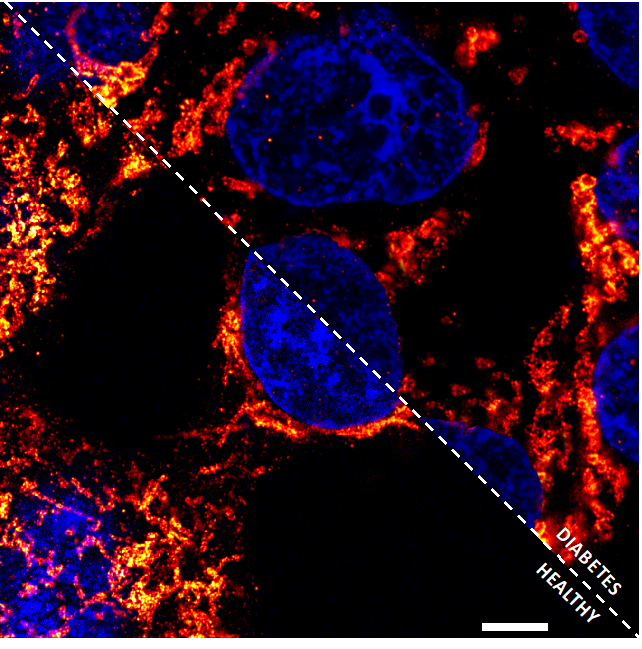
Confocal microscopy image showing cytokine-treated Ins-1E cells (on the right) and healthy cells (on the left) after staining with the specific marker for mitochondrial outer membrane TOM20 (red), and DAPI for nucleus (blue) to analyze the mitochondrial structure. The images were taken through a new super resolution method called Expansion Microscopy. Scale bar: 20 μm.
MiRNA-Dependent Regulation of NAFLD Pathogenesis with Emphasis on the Mitochondrial Aspect
By Maria Bograya, Center for Immunology and Cellular Biotechnology, Immanuel Kant Baltic Federal University

When Mitochondria Loves You Back
By Tanoy Dutta, Department of Chemistry, Indian Institute of Science Education and Research

Confocal microscopy image showing a U-87 MG cell stained with a mitochondria-targeting small molecule organic fluorophore Quinaldine Red to study the mitochondrial dynamics
Mitochondrial Red Eye
by Agnieszka Fedoruk-Wyszomirska, Institute of Bioorganic Chemistry, Polish Academy of Sciences

Confocal microscopy image showing the mitochondrial network, cytoskeleton, and nucleus in MRC5 cell after FC treatment stained with MitoTracker Red CMXRos, Alexa Fluor 488 phalloidin, and Hoechst 33342, respectively.
Uncovering Where the Mitochondrion Makes its Proteins
By Rolando Berlinguer Palmini and Matt Zorkau, Newcastle University

Synthesis of mitochondrial-encoded proteins in U20S cells was labelled with the methionine analogue HPG and detected by a fluorescent azide (green). Mitochondrial inner boundary membranes (magenta) were visualised by immunofluorescent labelling of Tim23. Stimulated emission depletion (STED) microscopy and surface rendering was used to determine sub-mitochondrial resolution of the targets.
MIRO1 Regulates Mitochondrial Trafficking in Cancer-Associated Fibroblasts
By Michael Cangkrama, ETH Zurich

MIRO1 labeling in the mitochondrial network of skin fibroblasts
Mitochondrion Before Oxaliplatin Storm
By Toni Martinez-Bernabe, University of Balearic Islands

Megacell
By Valentin Baumgartner, PhD student at the Laboratory for Urologic Oncology and Stem Cell Therapy, University Hospital Zurich

PC-3 prostate cancer cells were stained with TOM20 to analyse the mitochondrial network. Depicted here is one “Megacell” entangling other cells with its extensive mesh of mitochondria.
The Beauty & the Beast
By Arpit Mehrotra and Deepak Kumar Sharma, Council of Scientific & Industrial Research-Institute of Microbial Technology, India

SH-SY5Y cells were stained with Mitotracker-RED dye (in Red) and Hoechst dye (in Blue) to track mitochondrial networking in control (A) and synuclein transfected (B) cells, wherein beauty of mitochondrial networking was observed in control and the synuclein mediated beastly-broken network was observed upon its overexpression. Scale bar-20µm
Mitochondria run parallel in mature cardiomyocytes
By Erminia Donnarumma, Institut Pasteur, France

Adult primary cardiomyocytes (mouse) stained with TMRE (mitochondria, orange) and NucBlue (nuclei, blue).
Targeting Mitochondria 2022 Congress
October 26-28, 2022 - Berlin, Germany
wms-site.com
Dr. Ian Holt was Discerned the Best Scientific Award 2022
|
The World Mitochondria Society awarded Dr. Ian J. Holt, Instituto de Investigación Sanitaria Biodonostia, Spain for his scientific contribution 2-Deoxy-D-Glucose Couples Mitochondrial DNA Replication with Mitochondrial Fitness. Dr. Holt shared his future goals with the scoentific committee: "Continuing the collaboration with Professor Spinazzola (University College London), we have developed comprehensive future plans, which have attracted new funding". Dr. Holt's future plans include:
Dr. Holt stated: "These are exciting times for us and we hope to be able to share our substantial progress with you next year." In case you missed Targeting Microbiota 2022 meeting, you can demand for the recordings/abstract book access. Listen to Dr. Holt's Talk |
Targeting Mitochondria 2022 Congress
October 26-28, 2022 - Berlin, Germany
wms-site.com
Dr. John Ball was Awarded for His Innovation During Targeting Mitochondria 2022
|
Dr. John Ball, National Eye Institute (NEI), The National Institutes of Health (USA) received the Targeting Mitochondria Best Innovation Award. His innovative work on Mitochondria in Retinal Photoreceptors: More than Meets the Eye was awarded. Dr. Ball stated: "The finding that mitochondria in retinal photoreceptors have a prominent optical role provides a promising avenue to connect photoreceptor bioenergetics with noninvasive retinal imaging. To this end, we are currently developing our electromagnetic simulations to capture the influence of photoreceptor mitochondria on clinical imaging, and we plan to examine the connections between mitochondrial function and their optical characteristics." In case you missed the conference, you can still benefit from a 3 weeks access to Targeting Mitochondria 2022 presentations. |
Watch Dr. Ball's Presentation
October 26-28, 2022 - Berlin, Germany
wms-site.com
Short Oral Presentation Award 2022: Intra-Articular Injection of Mitochondria to Treat Osteoarthritis
 Mercedes Fernandez-Moreno, Instituto de Investigación Biomédica de A Coruña (INIBIC), Spain, was discerned the best short oral presentation award for her innovative talk on the Approach for Using Intra-Articular Injection of Mitochondria to Treat Osteoarthritis.
Mercedes Fernandez-Moreno, Instituto de Investigación Biomédica de A Coruña (INIBIC), Spain, was discerned the best short oral presentation award for her innovative talk on the Approach for Using Intra-Articular Injection of Mitochondria to Treat Osteoarthritis.
Nowadays there is not cure or an efficient treatment for osteoarthritis (OA), despite of its the most common rheumatology illness and a major cause of pain and disability in older adults. The relation between mitochondria alteration and OA was described in several studies in which the authors explained how mitochondrial alteration can modulate the chondrocyte function and its survival during this pathogenesis
Mitochondria have proposed as a potential therapeutic target for OA. Dr. Fernandez-Moreno and her team hypothesized that transplantation of heterologous mitochondria from healthy donor would ameliorate the OA effects. The analysis of in vivo model showed that mitochondria injection was safety and no inflammatory response was observed in the joint. These preliminary data gave them the possibility to continue studying the mitochondrial transplantation as an efficient treatment for OA.
Dr. Fernandez-Moreno stated to the World Mitochondria Society: "Taken into account our preliminary data, we will continue in the develop of more robust data generating a complete in vivo model to confirm the role of healthy mitochondria over the OA cartilage."
In case you missed Dr. Fernandez-Moreno's winning presentation, you can access the conference material here.
Targeting Mitochondria 2022 Congress
October 26-28, 2022 - Berlin, Germany
wms-site.com
Targeting Mitochondria 2022 Best Poster Presentation Awards

The #WorldMitochondriaSociety Scientific Committee awarded three poster presenters for the insightful research and strategic results that they presented during Targeting Mitochondria 2022. We will be looking forward to learning about their progress during the next edition.
 |
Peptide Mediated Mitochondrial Delivery of Temozolomide for Evading Cellular Resistance Mechanism Daniel Szames commented: "Future work involving mitochondria-targeted temozolomide include further exploring the therapeutic potential as well as exploring its use as a DNA-damage repair probe. The use of patient-derived glioblastoma stem cells will act as a relevant model to determine whether mitochondria-targeted temozolomide has clinical potential. This compound can also be used to investigate the role of other DNA-damage repair mechanisms in mitochondria; for example, to investigate the role of mismatch repair in mitochondria." |
 |
Mitochondrial Genomes Long Read Sequencing Methodology Applied to Multispecies for the Identification of Genetic Variants Sophie Dhorne-Pollet, Université Paris-Saclay, INRAE, France |
 |
Mitochondria Enriched NK Cell Therapy for Solid Tumors |
If you wish to review these posters, you can order the abstracts here.
Targeting Mitochondria 2022 Congress
October 26-28, 2022 - Berlin, Germany
wms-site.com




